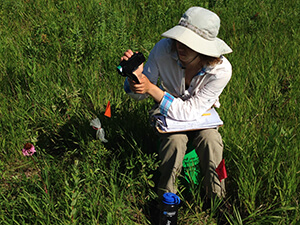
How good are honey bees at pollinating compared to other pollinators?
When I speak with most people about pollination, they talk about honey bees as the prime example of a highly effective pollinator. But this contrasts with the opinion of many scientists. Many of the scientists I speak with consider honey bees to be OK at pollinating, but not nearly as good as other pollinators, especially wild solitary bees.
So, what gives? Are honey bees excellent at pollinating? Or are they only average at pollinating? What are the attributes of effective vs. important pollinators, and do honey bees have these attributes? These are the topics for our forty-eighth Notes from the Lab, where we summarize “A meta-analysis of single visit pollination effectiveness comparing honeybees and other floral visitors,” written by Maureen Page, Charlie Nicholson, and other colleagues at UC Davis and published in the American Journal of Botany [2021].
For their study, Page and colleagues took a deep dive into the literature on single-visit effectiveness (SVE) for pollination. Single-visit effectiveness is a measure of how good a pollinator is at pollinating a flower on a per-visit basis. For example, SVE for a European honey bee (Apis mellifera) can be compared to SVE for a yellow-faced bumble bee (Bombus vosnesenskii) by measuring the amount of pollen deposited on a stigma (female part of the flower) when each of the bees visits the flower once. The honey bee would have higher SVE than the bumble bee if more pollen grains were deposited during that one visit.
In addition to pollen deposition, SVE can be measured by counting the number of developed pollen tubes, number of seeds produced in a fruit, number of fruits produced, or other measures of plant reproduction. Because lots of researchers have measured lots of different things for SVE, and more than 100 studies have been conducted on this topic, it can be difficult to summarize all of this information in a meaningful way. Enter something called meta-analysis.
Meta-analysis is a technique that’s used to summarize lots of studies in a rigorous and quantitative way. Meta-analysis controls for the type and quality of data from each individual study and allows researchers to compute an effect size, or magnitude of an effect with associated error. This allows researchers to say things like, “honey bees are 40% more effective than bumble bees,” or “honey bees are not significantly different from bumble bees” across all the studies that have been conducted on a topic. In total, the authors conducted their SVE meta-analysis on 168 studies that summarized 1,564 SVE measures for 240 plant species. A very nice dataset!
One way to think about SVE is that it represents the quality of a pollinator. In other words, once the organism is at the flower, SVE tells us how effective it is as a pollinator. But another factor that governs the importance of a pollinator is the quantity of visits it makes to flowers. For example, some pollinators might be extremely good at pollinating when they visit a particular plant, but if they rarely visit that plant, they may not be an important pollinator for the plant. To get a handle on the importance of various pollinators, the authors were able to use 26 studies of 50 plant species that assessed SVE and visitation frequency among at least five different species of pollinators. They compared the SVE (i.e., quality) and visitation frequency (i.e., quantity) data to estimate the importance of different pollinators.
So, what did they find? Are honey bees better or worse pollinators compared to other pollinator taxa? As seen in Figure 1, honey bees are less effective than the most effective non-honey bee pollinators (panel A), but as effective as the average pollinator (panel B). The most effective pollinators are often birds (e.g., hummingbirds; blue data points) and non-honey bee bees (green data points).
To interpret the figure, remember that honey bees are being compared to all other pollinators (categories: wasps, moths, flies, butterflies, birds, beetles, non-honey bee bees, and ants). If honey bees are as effective as another pollinator, the data points will fall on the vertical dashed line at x = 0. But instead, there’s a wide range in where the data points lie. The overall average for non-honey bee pollinators is indicated by the solid vertical line. Because the solid line is significantly further to the right of the dashed line in panel A, it indicates that the best non-honey bee pollinators are more effective than honey bees. However, even though the solid line is further to the right of the dashed line in panel B, it isn’t significantly different, indicating the average non-honey bee pollinator is as effective as a honey bee.
What about agricultural crop vs. non-crop flowers? Are honey bees particularly good at pollinating crops? Not compared to other bees. This might be surprising to many people since the narrative often ….


